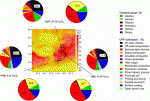Citation:

摘要:
Ozone (O3) pollution is becoming increasingly severe in China. In addition, our limited understanding of the relationship between O3 and volatile organic compounds (VOCs), is an obstacle to improving air quality. By developing an improved source-oriented speciated VOC emission inventory in 2013, we estimated the ozone formation potential (OFP) and investigated its characteristics in China. Besides, a comparison was made between our estimates and space-based observations from the ozone monitoring instrument (OMI) on the National Aeronautics and Space Administration (NASA)’s Aura satellite. According to our estimates, m-/p-xylene, ethylene, formaldehyde, toluene, and propene were the five species that had the largest potential to form ozone, and on-road vehicles, industrial processes, biofuel combustion, and surface coating were the key contributing sectors. Among different regions of China, the North China Plain, Yangtze River Delta, and Pearl River Delta had the highest OFP values. Our results suggest that O3formation is VOC-limited in major urban areas of China. Additionally, considering the different photochemical reactivities of various VOC species and the disparate energy and industry structures in the different regions of China, more efficient OFP-based and localized VOC control measures should be implemented, instead of the current mass-based and nationally uniform policies.
